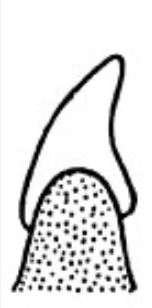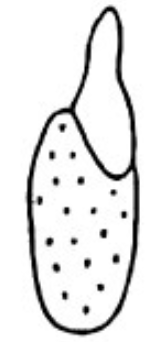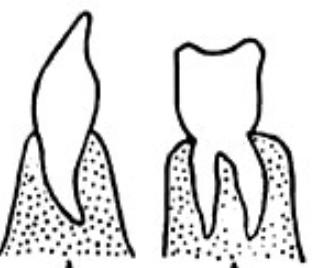herp study questions
1/49
There's no tags or description
Looks like no tags are added yet.
Name | Mastery | Learn | Test | Matching | Spaced |
|---|
No study sessions yet.
50 Terms
Monophyletic
A group that includes an ancestor and all of its descendants.
Paraphyletic
A group that includes an ancestor but not all of its descendants.
Polyphyletic
A group that does not include the common ancestor of the group.
Amplexus
The mating position of amphibians.
What is the ancestral amplexus form
inguinal
What is the derived amplexus form
axillary
Metamorphosis
Transformation process from larval to adult form.
do frogs do metamorphosis
ALWAYS
Neoteny
Retention of juvenile characteristics in the adult.
Progenesis
Attainment of sexual maturity at a juvenile stage.
Cutaneous respiration
Breathing through the skin.
Acrodont teeth
Teeth attached to the top of the jawbone.

Pleurodont teeth
Teeth attached to the inner side of the jawbone.

Thecodont teeth
Teeth set in sockets in the jawbone.

Jacobson’s organ
An olfactory sense organ in the roof of the mouth.
Anapsid
Skull type with no openings behind the eye.
Synapsid
Skull type with one opening behind the eye.
Diapsid
Skull type with two openings behind the eye.
Amniote
A group of tetrapods characterized by an amniotic egg.
Anuran
A frog or toad.
Urodela
The order of amphibians that includes salamanders.
Spermatophore
A package of sperm transferred during mating.
Unken reflex
Defensive posture in salamanders.
Plethodontidae
A family of lungless salamanders.
Caecilians
Legless amphibians with a worm-like appearance.
Suborder Pleurodira
A suborder of turtles including families Chelidae, Pelomedusidae, and Podocnemidae, known for their unique neck retraction sideways under the shell.
Suction Feeding
A feeding mechanism used by some turtles, like the family Chelidae, where they create a vacuum to draw in prey.
Alligator Snapping Turtle
A unique turtle species in the family Chelydridae known for its large size, powerful jaws, and a worm-like lure on its tongue to attract prey.
Suborder Cryptodira
A suborder of turtles with families like Cheloniidae and Dermochelyidae, known for retracting their neck vertically under the shell.
Leatherbacks
The largest extant turtles, belonging to the family Dermochelyidae, known for their unique leathery shell.
Regional Ectothermy
A thermoregulation strategy seen in some turtles, like Dermatemydidae, where body temperature varies in different body regions.
Hemipenes
Paired copulatory organs found in male squamates like lizards, used during mating to transfer sperm to females.
Parthenogenesis
A form of asexual reproduction seen in some squamates, where females produce offspring without fertilization by males.
Pineal/Parietal Eye
A light-sensitive organ found in some squamates, like Iguania, which helps regulate circadian rhythms and detect light changes.
Elapidae
A specialized family of snakes known for their venomous nature.
Species
Elapidae family features species like cobras, coral snakes, and mambas.
Key Characteristics
Elapids have hollow, fixed fangs at the front of their mouths, slender bodies, vibrant coloration for warning, and neurotoxic venom.
Hydrophiinae
A subfamily of Elapidae known as sea snakes, characterized by flattened tails for swimming and distribution in marine environments.
Atractaspididae
A family of snakes with small, fixed fangs at the front of their mouths and burrowing habits.
Cutaneous Respiration
False, snakes cannot fulfill their respiratory needs through cutaneous respiration.
Burmese Python
Their presence in the Florida Everglades has led to ecosystem destruction due to their impact on the trophic cascade and lack of natural predators.
Rubber Boa
During "wintering," these snakes hibernate in the fridge without losing calories, can go months without eating, and use the Jacobson Organ for scent detection.
Crocodilians
Grouped with Archosauria, now known as Archosauria including Testudines, they share traits with birds, exhibit aquatic behavior, and show parental care.
Crocodilian Decline
Historically threatened by habitat loss, hunting, and pollution, leading to severe population declines.
Crocodilian Sex Determination
Crocodiles have temperature-dependent sex determination, where the incubation temperature determines the sex of the offspring.
Alligatoridae
Family including alligators with notable species like American alligator, exhibiting specific behaviors, coloration, and prey preferences.
Crocodylidae
Family of crocodiles with diverse species, behaviors, and distributions, facing threats like habitat loss and hunting.
Gavialidae
Family including gharials, facing a dramatic decline due to habitat loss and conservation efforts aiding in their recovery.
Tuatara
A reptile group in Rhynchocephalia, sharing a common ancestor with squamates, not closely related to crocodiles, and exhibiting unique genomic features.
Sphenodontidae
The only family in Rhynchocephalia, characterized by unique skull and teeth, lack of intromittent organ, and problematic sex determination for populations.